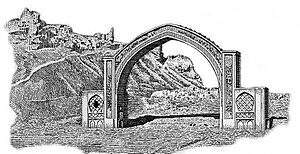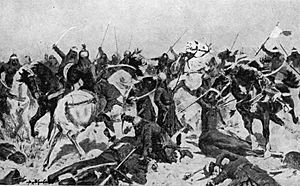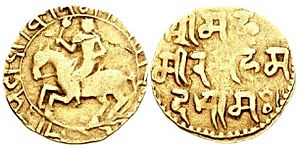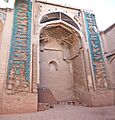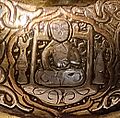Ghurid dynasty facts for kids
Quick facts for kids
Ghurid dynasty
|
|||||||||||||||||||||||
|---|---|---|---|---|---|---|---|---|---|---|---|---|---|---|---|---|---|---|---|---|---|---|---|
| 786–1215 | |||||||||||||||||||||||
| Capital | Firozkoh Herat Ghazni (1170s–1215) |
||||||||||||||||||||||
| Common languages | Persian (court, literature) | ||||||||||||||||||||||
| Religion | Before 1011: Paganism From 1011: Sunni Islam |
||||||||||||||||||||||
| Government | Hereditary monarchy Diarchy (1173–1206) |
||||||||||||||||||||||
| Malik/Sultan | |||||||||||||||||||||||
|
• 8th-century
|
Amir Banji (first) | ||||||||||||||||||||||
|
• 1214–1215
|
Zia al-Din Ali (last) | ||||||||||||||||||||||
| History | |||||||||||||||||||||||
|
• Established
|
786 | ||||||||||||||||||||||
|
• Disestablished
|
1215 | ||||||||||||||||||||||
| Area | |||||||||||||||||||||||
| 1200 est. | 2,000,000 km2 (770,000 sq mi) | ||||||||||||||||||||||
|
|||||||||||||||||||||||
The Ghurid dynasty was a powerful empire that ruled parts of Asia from the 8th century to 1215. They started as local leaders in the Ghor region of what is now central Afghanistan. Over time, they became very strong.
The Ghurids originally followed Paganism, but they slowly converted to Sunni Islam after the Ghaznavid ruler Mahmud of Ghazni conquered Ghor in 1011. At first, the Ghurids were like junior partners to bigger empires, the Ghaznavids and later the Seljuks.
However, in the early 1100s, the Ghaznavids and Seljuks started fighting a lot. This created a chance for the Ghurids to grow. They took over more land, especially in eastern Afghanistan and Punjab. Eventually, a Ghurid leader named Muhammad of Ghor captured Lahore in 1186. This ended the Ghaznavid rule and made the Ghurids a major power.
During the rule of two brothers, Ghiyath al-Din Muhammad and Muhammad of Ghor, the Ghurid empire became huge. It stretched from eastern Iran all the way to eastern India. Ghiyath al-Din focused on expanding west, reaching the Caspian Sea. Meanwhile, Muhammad of Ghor conquered vast areas in India, reaching as far as Bengal.
Sadly, Ghiyath al-Din Muhammad died in 1203. Soon after, the Ghurids suffered a big defeat in battle. Muhammad of Ghor was assassinated in 1206. This led to the quick decline of the Ghurid empire. By 1215, another empire, the Khwarazmian Empire, took over their lands. However, the Ghurid conquests in India continued under a new kingdom called the Delhi Sultanate.
Contents
The Ghurids: Who Were They?
Historians believe the Ghurid dynasty came from eastern Iran. They were likely Tajik people. Some older ideas suggested they were related to the Pashtun people, but most modern scholars disagree.
Ghurid princes often married people from different groups like Tajiks, Persians, Turks, and Afghans. This mix of cultures was common in their empire.
The Ghurids spoke a special Persian dialect from their mountain home in Ghor. However, like other empires of their time, they loved and supported Persian literature and Persian culture. Persian became the main language used in their royal courts and for official writings.
Some stories tried to connect the Ghurid family to ancient Iranian heroes. But these stories were likely made up later to make the Ghurids seem more important. We don't know much about their beliefs before they became Muslim.
Rise of the Ghurid Empire
The Ghurids began as local rulers in Ghor. An early Ghurid prince named Amir Banji was recognized by the Abbasid ruler Harun al-Rashid. For about 150 years, the Ghurids were under the control of the Ghaznavids and Seljuks.
In the mid-1100s, the Ghurids started to become independent. A Ghaznavid ruler, Bahram-Shah of Ghazna, poisoned a Ghurid leader named Qutb al-Din Muhammad. This made Qutb's brother, Sayf al-Din Suri, very angry. Sayf attacked Ghazni and defeated Bahram-Shah. But Bahram-Shah fought back and captured Sayf, who was then killed.
Another brother, Ala al-Din Husayn, became the new Ghurid king. He swore to get revenge. He defeated Bahram-Shah and completely destroyed the city of Ghazni. The city burned for seven days and nights! This earned him the nickname Jahānsūz, meaning "the world burner."
Battles with the Seljuks
In 1152, Ala al-Din Husayn stopped paying tribute to the Seljuks. He was defeated and captured by the Seljuk Sultan Ahmad Sanjar. Ala al-Din was held prisoner for two years until a large ransom was paid.
However, Sultan Sanjar was soon captured by other groups in 1153. This gave the Ghurids a chance to expand again. Ala al-Din Husayn spent the rest of his rule conquering more lands, including parts of Khurasan. He died in 1161, and his son Sayf al-Din Muhammad took over, but he died in battle two years later.
During Ala al-Din's time, the Ghurids made Firuzkuh their capital. Other parts of the Ghurid family also settled in places like Bamiyan.
The Ghurid Empire at its Peak
After Sayf al-Din Muhammad died, his cousin Ghiyath al-Din Muhammad became king. He was a very skilled ruler. With the help of his loyal brother, Muhammad of Ghor, Ghiyath defeated rivals and expanded the Ghurid lands.
In 1173, Muhammad of Ghor recaptured Ghazni from the Oghuz Turks. In 1175, the Ghurids took Herat from the Seljuks. Herat became an important center for their culture. They also took control of other areas and reached as far as the Seljuk lands in Kerman.
Conquering Khorasan
The Ghurids then started fighting the Khwarezmid Empire for control of Khorasan. This region was in chaos after the Seljuks lost power in 1153. In 1192, the Ghurids defeated a Khwarezmian leader near Merv and took over his lands. After the Khwarezmian ruler Tekish died in 1200, the Ghurids took all of Khorasan, capturing Nishapur and reaching Bastam.
Ghiyath al-Din Muhammad died in 1203. His brother Muhammad of Ghor became the sole ruler. However, Muhammad was assassinated in 1206. This marked the end of Ghurid power in Khurasan.
Conquering India (1175 to 1205)
Before the Ghurids invaded India, northern India was ruled by many independent Rajput kings. These kings often fought among themselves. Important rulers included Prithviraja III in Delhi and Ajmer, Mularaja II in Gujarat, and Jayachandra in Kanauj.
Muhammad of Ghor led the Ghurid invasion of northern India and Bengal between 1175 and 1205. His capital was Ghazni, while his brother Ghiyath al-Din ruled the western part of the empire from Firozkoh.
In 1175, Muhammad crossed the Indus River and captured Multan and Uch. In 1178, he tried to enter Gujarat through the Thar desert, but his tired army was defeated by a group of Rajput chiefs near Mount Abu. This made him change his plans for future attacks.
Muhammad then focused on the Ghaznavids, who still held parts of Punjab. He captured Sindh, Peshawar, and Sialkot. In 1186, he finally took Lahore, the last Ghaznavid stronghold, after several attempts.
In 1191, the Ghurids attacked Bathinda and marched towards Delhi. They were defeated in the First Battle of Tarain by a Rajput army led by King Prithviraja III. However, Muhammad returned a year later with a larger army. In the Second Battle of Tarain, he completely defeated the Rajput forces and executed Prithviraja.
After this victory, Muhammad's general, Qutbu l-Din Aibak, conquered Delhi in 1193. Aibak became the governor of these new lands. In 1194, Muhammad defeated King Jayachandra of the Gahadavala dynasty at the Battle of Chandawar. The city of Benares was taken, and many temples were destroyed. This wealth helped Muhammad fund his empire's expansion.
Around 1203, another Ghurid general, Bakhtiyar Khalji, moved into Bengal. In Bihar, he destroyed important Buddhist learning centers like Nalanda University. In Bengal, he sacked the city of Nudiya and set up an Islamic government in Lakhnauti in 1205.
Muhammad of Ghor placed his trusted Turkic generals in charge of the conquered Indian lands, not his own Ghurid relatives. After Muhammad was assassinated in 1206, his empire in India broke into smaller kingdoms led by these generals. For example, Qutb al-Din Aibak became the Sultan of Delhi. These different rulers fought for power until the Sultan of Delhi, Iltutmish, won. This led to the start of the Mamluk dynasty, which was the first of five dynasties that formed the Delhi Sultanate. This Sultanate ruled most of India for over 300 years.
Decline and Fall of the Ghurids
When Ghiyath al-Din Muhammad died in 1203, Muhammad of Ghor became the sole ruler. Soon after, the Khwarazmian Empire attacked the Ghurids. In the Battle of Andkhud in 1204, the Ghurid army was completely defeated by the Khwarazmians and their allies. This loss meant the Ghurids lost control of most of their lands in Khurasan.
Muhammad of Ghor gathered a new army to get revenge. However, he had to go to Punjab to stop a rebellion. On his way back, he was assassinated in March 1206.
After Muhammad Ghori's death, the remaining Ghurid leaders and the Khwarazmians fought for control. The Khwarazmians captured Herat and Ghor in 1206, and finally Ghazni in 1215. This completed their takeover of the western Ghurid empire. The Ghurid capital was moved to Delhi, recognizing the Khwarazmian rule in Afghanistan.
Even though the Ghurid empire itself didn't last long, Muhammad of Ghor's conquests in India were very important. They laid the groundwork for Muslim rule in India, which continued for centuries under the Delhi Sultanate.
Ghurid Culture and Legacy
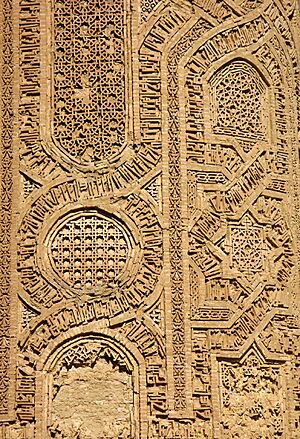
The Ghurids greatly supported Persian culture and literature. They helped create a Persian-influenced state in India. Sadly, much of the literature from their time has been lost. They also brought Iranian architecture styles to India.
The Ghurid state led to the creation of the Delhi Sultanate. This new kingdom made Persian the official court language in India. Persian remained important there until the 1800s.
There were many Turkic people in the Ghurid armies, especially as soldiers. These different groups, including Tajiks, Persians, Turks, and Afghans, mixed together. The Turks in the Ghurid empire kept their own language and traditions, often seen as "men of the sword" (soldiers) compared to the Persians, who were "men of the pen" (scholars and administrators).
Images for kids
-
The two mausoleums of Chisht (the western was built in 1167)
-
Ruins of the Shah-i Mashhad madrasa (built in 1176)
-
Great Mosque of Herat: Ghurid entrance (iwan) with remains of Ghurid inscriptions. 1200–1201 CE.
-
A beautiful ewer from Herat, dated 1181–1182.






